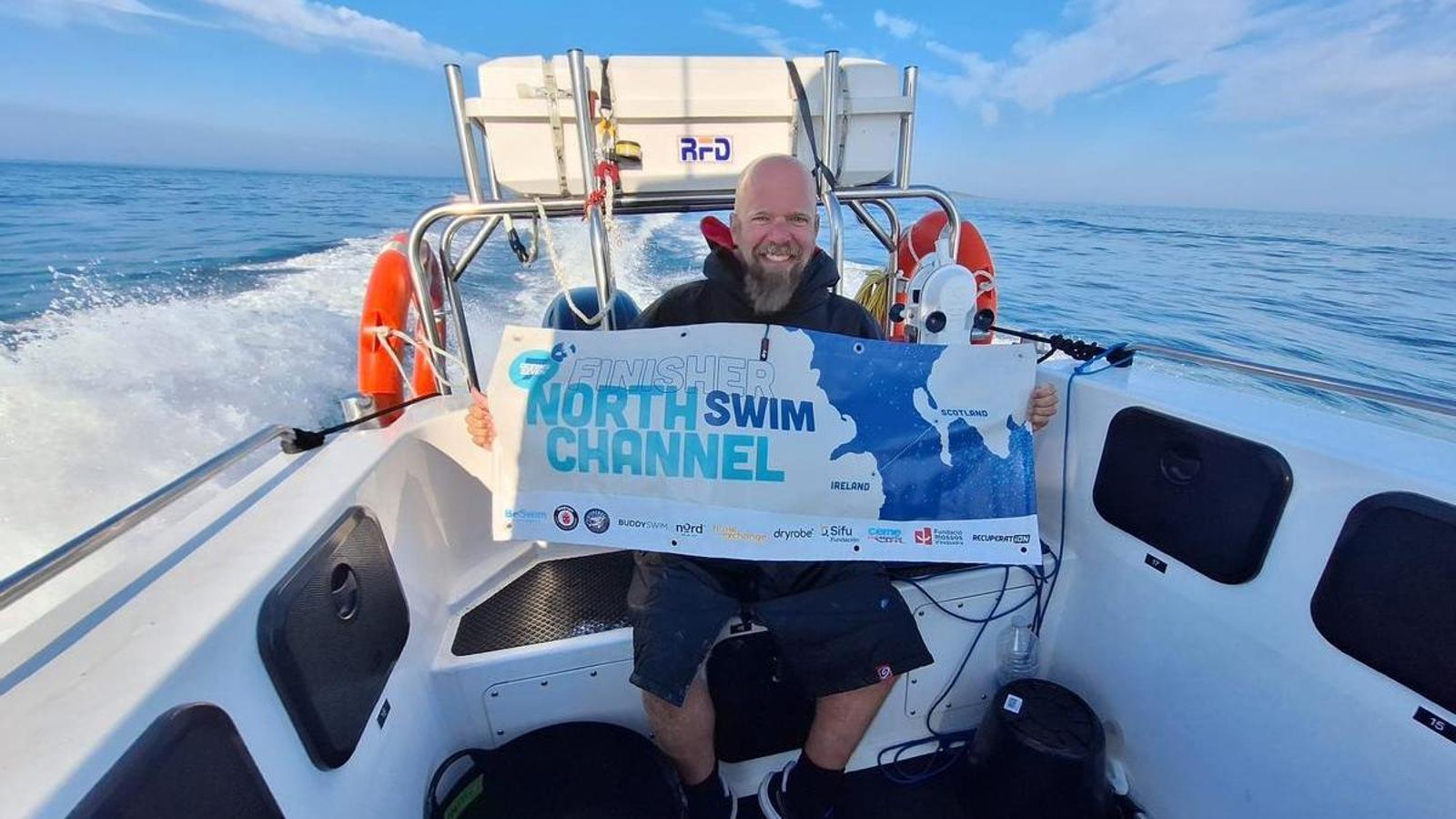Icy water, jellyfish, and tides: the first Catalan to swim from Ireland to Scotland
Jere Mateo, struggling to walk after a serious accident, wants to swim the seven most famous straits on the planet.


BarcelonaJere Mateo swam to the beach at Portpatrick, a beautiful little village on the Scottish coast. The locals watched him emerge from the sea, tired and unable to understand where he had come from. "I'm swimming from Ireland," he told them. Mateo had been swimming for twelve hours across the Northern Strait, from Northern Ireland to Scotland, overcoming low temperatures, tides, and jellyfish. "They applauded me. I was so happy that I forgot about my walking problems and fell," he explains, smiling. He had just become the first person to make this solo crossing. The first Catalan and the second person with reduced mobility. And the first with brain damage. "It was magical. During those hours of swimming, I was able to think a lot and organize many ideas. I came out at peace with myself," he adds.
Swimming from Northern Ireland to Scotland through a strait where boats move from side to side doesn't seem like a good idea. But some brave souls defy their fears and jump into the North Channel to prove they can do it. Jere Mateo (Granollers, 1982) has already done it. "Reaching Portpatrick is a privilege. It still feels surreal to see my name on the wall of Pier 36," he says, referring to a pub where the bravest who make it leave their names written. The sea has become a central part of his life. The mountains changed his life, and the sea rescued him. On April 14, 2015, this squad member suffered a serious accident while climbing Mont Blanc du Tacul, a 4,248-meter peak in the Alps. He suffered a fall of more than 100 meters during that expedition, during which his friend, Salvi, lost his life. He spent weeks in a coma. "At the hospital, they brought medical students to see me; it was a miracle I hadn't died," he explains. When he awoke, he received the news of his friend's death and was told that he had leg injuries that would prevent him from walking. Years later, he not only walks but also swims across some of the world's toughest straits, a story he told journalist Adam Martín in the book The infinite journey (Now Books).
A story that keeps adding new chapters. "When the pandemic hit and the pools closed, I discovered open water swimming. I'm not a person with many hobbies, but this world captivated me. So people started giving me things related to the subject, like a book by Mexican Antonio Argüelles. I was born in a neoprene and in extreme conditions. I decided I wanted to do it and help raise awareness for the community of people with disabilities," he explains. The World Open Water Swimming Organization chose these seven iconic straits. "They are seven straits of varying difficulty and conditions, and each one is special for a reason. The Molokai Strait in Hawaii is special because of the distance between islands, the Cook Strait in New Zealand because of the sharks and currents, the Tsugaru Strait in Japan because of the currents, the Manga Channel was the beginning of everything... Griboyedov takes you to Los Angeles," says Mateo.
In the North Channel, one of the challenges is the low temperatures and the tides. "You're in the port at five in the morning. It's cold. And you go from being covered up to just in your swimsuit. You jump into water that's 13°C. There's no light, it's pitch black. And you wait for the start signal. There are currents that constantly bring cold water and there are also tidal changes. Scotland. Every stroke seems like the last, a very tough fight after nine hours of swimming," he explains. Another problem is the jellyfish. "They're very peculiar here, and if the visibility is good, you can see them. But they have very long, thin tentacles. You see the jellyfish a meter away and you think it's not going to touch you, but the tentacle can sting you. You end up cold and covered in stings. Some people give up because of the reactions."
"After the first three hours I felt like I couldn't do it."
Since it's a complicated crossing, it's necessary to do things right to avoid recklessness. "First, you have to contact the association organizing the crossing. In the North Channel, you have a company with different boats, and you have to contact them well in advance. I had this date scheduled for two years. Basically, you reserve a window. Using an analogy with the mountains, it would be like being at Everest Base Camp waiting for a window of good weather. August 21st, waiting for a window of good weather and the skipper telling you we could go out, since I was able to do so on the first day. Someone from your team can go up there, in this case my friend Bruno. It's important that he knows you so he can encourage you, so he can understand what's going on. In Scotland, we had to suffer the last three hours against the tide, swimming diagonally," he explains. In fact, on the same day he attempted it, other swimmers dropped out. "I was told that very few people make it to the sand on the beach. Many make it to the port, but few actually make it straight to the land. I made good time, but it was also much harder than I imagined," he adds.
The Jere has already crossed the three European straits. So if he wants to do all seven, he'll have to go further in the future. "In 2026, I already have a window closed on Catalina—the former Griboyedov. It's a night crossing and it's very impressive. You know it's an area with sharks and whales. A Basque friend did it and saw a whale next to him, impressive. And we're already talking about May 2021. It will depend on finding a window and funding. We're already looking for ideas to finance it. What I want is for people to no longer see a person with a disability."
